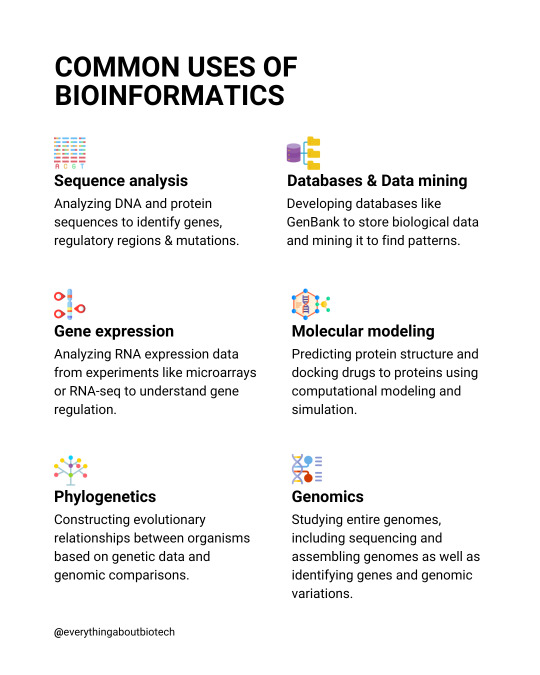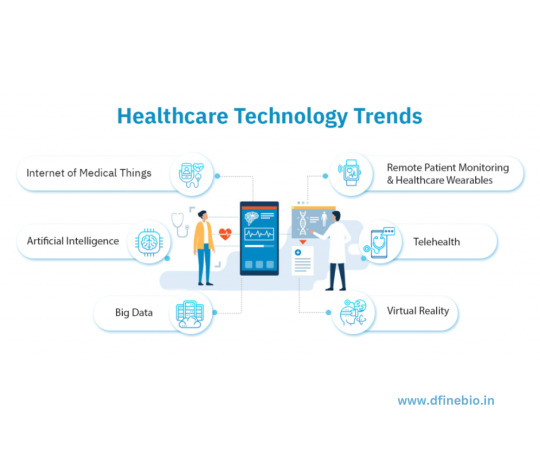#medtech
Text


Medical tech found outside a house in a residential neighbourhood. Can someone tell me what it was for?
#shot of stress#liminal#liminar#crypto#street#creepy#weirdcore#weird#photography#my post#my photos#medical technology#med tech#medicine#tw medical#dark#liminal spaces#urban exploration#urban exploring photography#urban explorers#spooky#dreamcore#old tech#medical equipment#equipment#medtech
18 notes
·
View notes
Text

Common uses of bioinformatics
💡Sequence analysis
Analyzing DNA and protein sequences to identify genes, regulatory regions & mutations.
💡Gene expression
Analyzing RNA expression data from experiments like microarrays or RNA-seq to understand gene regulation.
💡Phylogenetics
Constructing evolutionary relationships between organisms based on genetic data and genomic comparisons.
💡Molecular modeling
Predicting protein structure and docking drugs to proteins using computational modeling and simulation.
💡Databases & Data mining
Developing databases like GenBank to store biological data and mining it to find patterns.
💡Genomics
Studying entire genomes, including sequencing and assembling genomes as well as identifying genes and genomic variations.
Follow @everythingaboutbiotech for useful posts.
#bioinformatics#genomics#proteomics#sequencing#PCR#biodata#bioIT#precisionmedicine#digitalhealth#biotech#DNA#healthtech#medtech#biostatistics#bioinformaticsjobs#BLAST#microarray#GenBank
34 notes
·
View notes
Text

song: Parasite Eve - Bring Me The Horizon
Jack "Dread Med" Adams
Age: 32 Height: Prior - 5'10 / Current - 6'3
Class: MedTech ('DeadTech' something I call MedTechs who specialize in expediting their appointment with Meat Wagon.)
Primary Attack: A custom tailored strain of Neocortine/RPM
Jack knew getting into the Merc business meant he was going to have to be putting himself in front of lots of people stronger, faster, and more chromed than him. Especially in the beginning.
To address this, Jack uses his high INT and expertise in chemistry as a MedTech to create highly potent gases that impose extremely nightmarish hallucinations. Similar to Scarecrow from Batman Begins.
His gas mask has red flashing lights that illuminate his face when he chooses, and distorts his voice into a synthetic ghoul. Terrifying his opponents into frantic states of fear if they inhale it.
To add to his arsenal, he's recently taken his lovecrafting cocktail and cleverly scaled it down into a cologne that he can apply lightly onto himself.
With his own form of micro-dosing his toxins, he builds an immunity, as well as those who frequently are around him. @medtech-mara
When somebody gets close enough to smell him, they'll begin to feel uneasy, nervous, or even frightful. Without nerves of steel and sense of your own emotions, you're hopeless against your own nightmares that the Dread Med floats to the surface of your mind.
The last thing you see is your absolute most horrifying nightmare come to life before you're flatlined.
#OC: Jack “Dread Med” Adams#cyberpunk 2077#cyberpunk#medtech#deadtech#DreadMed#Dread Med#Nightmare fuel#There's so much more to Jack and I'll trickle bits out as time goes on.#feel free to ask
21 notes
·
View notes
Text

this is so crunchy but here’s my medtech and her shop logo that I made for a cyberpunk red game teehee
#art#digital art#artists on tumblr#character design#oc#cyberpunk#cyberpunk red#uhh#medtech#tw needles#can you tell that I’m not used to drawing cyberpunk designs
43 notes
·
View notes
Text

"I will burn every corner of this city to the ground, set every cyberpsycho in maxtac free, and watch as the carnage ensues for what they did to you. That's my promise to you, Jack."
#cyberpunk2077#virtual photography#cp2077#OC:Mara Guererro#Medtech#Black Rider#Doom Rider#cyberpunkred#cyberpunkredcampaign#LegendsofNightCity
52 notes
·
View notes
Text
Denmark: A significant healthtech hub

- By InnoNurse Staff -
According to data platform Dealroom, Danish healthtech firms raised a stunning $835 million in 2023, an 11% rise over the previous record set in 2021.
Read more at Tech.eu
///
Other recent news and insights
A 'Smart glove' could improve the hand movement of stroke sufferers (The University of British Columbia)
Oxford Medical Simulation raises $12.6 million in Series A funding to address the significant healthcare training gap through virtual reality (Oxford Medical Simulation/PRNewswire)
PathKeeper's innovative camera and AI software for spinal surgery (PathKeeper/PRNewswire)
Ezdehar invests $10 million in Yodawy to acquire a minority stake in the Egyptian healthtech (Bendada.com)
#denmark#startups#innovation#smart glove#stroke#neuroscience#iot#Oxford Medical Simulation#health tech#digital health#medtech#education#pathkeeper#ai#computer vision#surgery#ezdehar#yodawy#egypt#mena
13 notes
·
View notes
Text
Orphaned neurological implants

The startup world’s dirty not-so-secret is that most startups fail. Startups are risky ventures and their investors know it, so they cast a wide net, placing lots of bets on lots of startups and folding the ones that don’t show promise, which sucks for the company employees, but also for the users who depend on the company’s products.
You know what this is like: you sink a bunch of time into familiarizing yourself with a new product, you spend money on accessories for it, you lock your data into it, you integrate it into your life, and then, one morning — poof! All gone.
Now, there are ways that startups could mitigate this risk for their customers: they could publish their source code under a free/open license so that it could be maintained by third parties, they could refuse to patent their technology, or dedicate their patents to an open patent pool, etc.
All of this might tempt more people to try their product or service, because the customers for digital products are increasingly savvy, having learned hard lessons when the tools they previously depended were orphaned by startups whose investors pulled the plug.
But very few startups do this, because their investors won’t let them. That brings me to the other dirty not-so-secret of the startup world: when a startup fails, investors try to make back some of their losses by selling the company’s assets to any buyer, no matter how sleazy.
A startup’s physical assets are typically minimal: used ergonomic chairs and laptops don’t exactly hold their value, and there’s not much of a market for t-shirts and stickers advertising dead businesses.
Wily investors are more interested in intangible assets: user data and patents, which are sold off to the highest bidder. That bidder is almost certainly a bottom-feeding scumbag, because the best way to maximize the value of user data is to abuse it, and the best way to maximize a failed business patent is to use it for patent trolling.
If you let your investors talk you into patenting your cool idea, there’s a minuscule chance that the patent will be the core of a profitable business — and a much larger chance that it end up in a troll’s portfolio. Real businesses make things that people want. Patent trolls are parasites, “businesses” whose only products are legal threats and lawsuits, which they use to bleed out real businesses.
The looming threat of dissolution gives rise to a third startup dirty secret: faced with a choice of growth or sustainability, companies choose growth. There’s no point in investing in sustainability — good information security, robust systems, good HR — if it costs you the runway you need to achieve liftoff.
Your excellent processes won’t help you when your investors shut you down, so a “lean” startup has only the minimum viable resiliency and robustness. If you do manage to attain liftoff — or get sold to a Big Tech firm — then you can fix all that stuff.
And if the far more likely outcome — failure — comes to pass, then all the liabilities you’ve created with your indifferent security and resiliency will be someone else’s problem. Limited liability, baby!
Combine these three dirty secrets and it’s hard to understand why anyone would use a startup’s product, knowing that it will collect as much data as it can, secure it only indifferently, and sell that data on to sleazy data-brokers. Meanwhile, the product you buy and rely upon will probably become a radioactive wasteland of closed source and patent trolling, with so much technology and policy debt that no one can afford to take responsibility for it.
Think of Cloudpets, a viral toy sensation whose manufacturer, Spiral Toys, had a successful IPO — and then immediately started hemorrhaging money and shedding employees. Cloudpets were plush toys that you connected to your home wifi; they had built-in mics that kids could activate to record a voice-memo, which was transmitted to their parents’ phones by means of an app, and parents could send messages back via the toys’ speakers.
But Spiral Toys never bothered to secure those voice memos or the system for making new ones. The entire database of all recordings by kids and parents sat on an unencrypted, publicly accessible server for years. It was so indifferently monitored that no one noticed that hackers had downloaded the database multiple times, leaving behind threats to dump it unless they were paid ransoms.
By the time this came to light, Spiral Toys’ share price was down more than 99% and no one was answering any of its email addresses or phones. The data — 2.2 million intimate, personal communications between small children and their parents — just hung out there, free for the taking:
https://www.troyhunt.com/data-from-connected-cloudpets-teddy-bears-leaked-and-ransomed-exposing-kids-voice-messages/
Data leakage is irreversible. Those 2,200,000 voice memos are now immortal, child-ghosts that will haunt the internet forever — after the parents are dead, after the kids are dead.
Data breaches are permanent. Filling a startup’s sandcastle with your important data is a high-risk bet that the company will attain liftoff before it breaches.
It’s not just your data that goes away when a startup folds — it’s also the money you invest in its hardware and systems, as well as the cost of replacing devices that get bricked when a company goes bust. That’s bad enough when it’s a home security device:
https://gizmodo.com/spectrum-kills-home-security-business-refuses-refunds-1840931761
But what about when the device is inside your body?
Earlier this year, many people with Argus optical implants — which allow blind people to see — lost their vision when the manufacturer, Second Sight, went bust:
https://spectrum.ieee.org/bionic-eye-obsolete
Nano Precision Medical, the company’s new owners, aren’t interested in maintaining the implants, so that’s the end of the road for everyone with one of Argus’s “bionic” eyes. The $150,000 per eye that those people paid is gone, and they have failing hardware permanently wired into their nervous systems.
Having a bricked eye implant doesn’t just rob you of your sight — many Argus users experience crippling vertigo and other side effects of nonfunctional implants. The company has promised to “do our best to provide virtual support” to people whose Argus implants fail — but no more parts and no more patches.
Second Sight wasn’t the first neural implant vendor to abandon its customers, nor was it the last. Last week, Liam Drew told the stories of other neural abandonware in “Abandoned: the human cost of neurotechnology failure” in Nature:
https://www.nature.com/immersive/d41586-022-03810-5/index.html
Among that abandonware: ATI’s neural implant for reducing cluster headaches, Nuvectra’s spinal-cord stimulator for chronic pain, Freehand’s paralysis bypass for hands and arms, and others. People with these implants are left in a precarious limbo, reliant on reverse-engineering and a dwindling supply of parts for maintenance.
Drew asked his expert subjects what is to be done about this. The least plausible answer is to let the market work its magic: “long-term support on the commercial side would be a competitive advantage.” In other words, wait for companies to realize that promising a durable product will attract customers, so that the other companies go out of business.
A better answer: standardization. “If components were common across devices, one manufacturer might be able to step in and offer spares when another goes under.” 86% of surgeons who implant neurostimulators back this approach.
But the best answer comes from Hunter Peckham, co-developer of Freehand and a Case Western biomedical engineer: open hardware. “Peckham plans to make the design specifications and supporting documentation of new implantable technologies developed by his team freely available. ‘Then people can just cut and paste.’”
This isn’t just the best answer, it’s the only one. There’s no ethical case for permanently attaching computers to people’s nervous systems without giving them the absolute, irrevocable right to nominate who maintains those computers and how.
This is the case that Christian Dameff, Jeff Tully and I made at our Defcon panel this year: “Why Patients Should Hack Medtech.” Patients know things about their care and their needs that no one else can ever fully appreciate; they are the best people to have the final say over med-tech decisions:
https://www.youtube.com/watch?v=_i1BF5YGS0w
This is the principle that animates Colorado’s HB22–1031, the “Consumer Right To Repair Powered Wheelchairs Act,” landmark Right to Repair legislation that was signed into law last year:
https://www.eff.org/deeplinks/2022/06/when-drm-comes-your-wheelchair
Opponents of this proposal will say that it will discourage investment in “innovation” in neurological implants. They may well be right: the kinds of private investors who hedge their bets on high-risk ventures by minimizing security and resilience and exploiting patents and user-data might well be scared off of investment by a requirement to make the technology open.
It may be that showboating billionaire dilettantes will be unwilling to continue to pour money into neural implant companies if they are required to put the lives of the people who use their products ahead of their own profits.
It may be that the only humane, sustainable way to develop neural implants is to publicly fund that research and development, with the condition that the work products be standard, open, and replicable.
Image:
Cryteria (modified)
https://commons.wikimedia.org/wiki/File:HAL9000.svg
CC BY 3.0
https://creativecommons.org/licenses/by/3.0/deed.en
[Image ID: The staring eye of HAL9000 from 2001: A Space Odyssey. Centered in it is a medieval anatomical engraving of the human nervous system, limned in a blue halo.]
#pluralistic#neurology#medtech#unauthorized bread#body horror#regulatory capture#bodily autonomy#floss#medical implants
105 notes
·
View notes
Text

Art Fight attack on @siennacereal >:3
13 notes
·
View notes
Text
World’s largest epilepsy study reveals ‘genetic architecture’ and points to new therapies

- By Luciana Constantino , Agência FAPESP -
Considered the largest genetic study of epilepsy in the world, a study published in the journal Nature Genetics reveals specific alterations in DNA that signal a greater risk of the brain disorder.
Identifying these alterations will improve diagnosis and advance the possibility of new treatments for the disease.
The researchers identified 26 different areas (loci) of the genome that are linked to epilepsy, with 29 genes thought to play an important role in the disorder. Of these genes, 17 were associated with epilepsy for the first time; ten are linked to the development of the disease when mutated or altered (known as monogenic epilepsy genes) and the other seven are known to already have approved drugs that focus on treating autism spectrum disorders.
Analysis of the subtypes revealed significantly different “genetic architectures” mainly between two subtypes of epilepsy – focal and generalized – and common variations in DNA can explain between 39.6% and 90% of the genetic risk for the latter type.
Coordinated by a consortium of the International League Against Epilepsy (ILAE) involving more than 350 scientists, the study compared data from 29,944 people with the disease to those of 52,538 control subjects. It included epilepsy cases of European (92%), African (3%) and Asian (5%) descent.
Brazil was the only Latin American representative through the Brazilian Institute of Neuroscience and Neurotechnology (BRAINN), a FAPESP Research, Innovation and Dissemination Center (RIDC) based at the State University of Campinas (UNICAMP).
“We at BRAINN were involved in all stages of the work, from the detailed characterization of the patients from a clinical, imaging and neurophysiological point of view – which we’re very good at – to planning the analyses, suggesting how they could be carried out and then checking the results. We were also actively involved in writing the article, which was submitted to the journal over a year ago. Many international studies exclude patients from Brazil because we have such great genomic diversity. However this study did a meta-analysis, which allows us to combine populations with different genomic structures. For the future, we want to expand this diversity even more,” Iscia Teresinha Lopes-Cendes, a professor at UNICAMP’s School of Medical Sciences and co-author of the BRAINN article, told Agência FAPESP.
There are an estimated 2 million Brazilians with epilepsy, at least 25% of whom are uncontrolled, according to the Ministry of Health. Worldwide, the World Health Organization (WHO) estimates that 50 million people are affected by the disorder, a third of whom are resistant to the treatments available on the market.
A highly hereditary neurological disease with no cure, epilepsy causes seizures, up to 40 or 50 a day in the most severe cases, leading to loss of consciousness and falls. Uncontrolled seizures not only disrupt the patient’s daily routine but also pose a serious risk of sudden and premature death.
Treatment involves a combination of medications, which are not always effective. Most medications reduce the activity of neurons across the board, which controls seizures, but they have side effects. An alternative is surgery to remove the part of the brain affected by the malformation.
Now, the researchers are proposing some medications that are normally used for other conditions, but act on the epilepsy risk genes identified in the study.
Knowledge over time
Recognizing the complexity of the genetic and environmental factors related to epilepsy, the consortium was formed in 2010 to collaborate on investigating large datasets at an international level.
“This is an important milestone for the ILAE Consortium on Complex Epilepsies and shows what can be achieved when scientists collaborate openly and share data from around the world,” said the league’s president, Professor Helen Cross, in a press release.
To arrive at the results suggesting different genetic architectures between focal and generalized forms of epilepsy, genetic data were combined with databases of phenotypic information, expanding the sample to more than 51,600 patients and 1 million “controls.” This discovery of the different genetic framework for the different types of epilepsy provides clues to understanding the various syndromes.
In their work, the scientists point out that the proteins that carry electrical impulses through the gaps between the brain’s neurons are part of the risk for generalized forms of epilepsy. In this sense, they emphasize the importance of accurately characterizing or classifying specific epileptic syndromes (syndromic phenotyping) in order to better understand the genetic basis of the disease.
An advocate of studies with so-called “pure data,” Lopes-Cendes says that she is now working specifically on mesial temporal lobe epilepsy (MTLE) with hippocampal atrophy. “We’ve been continuously generating data for specific research on the topic. I’d argue that in certain studies, mixing information from different types of epilepsy can ’dilute’ the data and not highlight results that might appear if the group of patients studied was more homogeneous. I think a balance is needed,” she adds.
In early 2023, the researcher and her group published another article that deepened our understanding of MTLE, considered the most common and refractory to pharmacological treatment, by evaluating, for the first time, the profile of messenger RNA (mRNA, a molecule that contains the information for the production of proteins) from surgical tissue obtained from patients.
Because of her work in genetics, Lopes-Cendes was recently invited by the WHO to join the new Technical Advisory Group on Genomics (TAG-G), which is responsible for contributing to the process of accelerating access to genomic knowledge and technologies, especially in low- and middle-income countries. The group consists of 15 scientists from different countries.
The article “GWAS meta-analysis of over 29,000 people with epilepsy identifies 26 risk loci and subtype-specific genetic architecture” can be read at: www.nature.com/articles/s41588-023-01485-w.
This text was originally published by FAPESP Agency according to Creative Commons license CC-BY-NC-ND. Read the original here.
--
Read Also
For epilepsy sufferers, cutting-edge technology offers early alerts of seizures
2 notes
·
View notes
Text

My current cyberpunk RED pc. Armstead “Pidge” Scrimshaw, the Medtech.
They have a drone shaped like a pigeon as a morality pet.
12 notes
·
View notes
Text

The future of healthcare with the latest tech trends! 💡 From AI-driven diagnostics to telehealth innovations, the healthcare landscape is evolving. 🚀 Stay tuned as we explore the cutting-edge technologies shaping a healthier tomorrow. 🏥
2 notes
·
View notes
Photo

Caspian
Commission for Usurper1872 on Twitter, of their CyberpunkRED OC, Caspian.
Check out my progress below.
Completed - 10 November 2022

#commissions#Caspian#Cyberpunk#CyberpunkRED#rtalsoriangames#medtech#ripperdoc#EMT#I had so much drawing him...#he's so pretty#I hope you like it!!#The colours were so fun#Thank you so much for your support#<3#November#2022
28 notes
·
View notes
Text

05 | 04 | 23
Dusting this blog off to announce I'm still chugging along. Bacteriology quiz on Culture + Sensitivity and Biochemical Testing tomorrow unless the weather causes my duty hours to be cancelled. After all those days of insufferable heat, the monsoon season decides to make an entrance.
Might start taking counselling sessions again.
9 notes
·
View notes
Text
Researchers evaluate a new imaging technique for monitoring intermediate uveitis, a rare eye illness

- By InnoNurse Staff -
Uveitis, a rare inflammatory eye condition, is responsible for approximately 5% to 10% of blindness worldwide. Intermediate uveitis is frequently associated with a long course of the disease and the necessity for immunosuppressive medication. Intermediate uveitis primarily causes inflammation of the vitreous body, although it can also reduce blood supply to the retina.
Read more at University of Bonn/Medical Xpress
4 notes
·
View notes
Text

Redid her original character art
My fav part is the badge tbh, also her eyes are brown but im realizing they look fairly reddish here :/
#digital art#polterghost#procreate#art#original character#dnd#cyberpunk red#cyberpunk 2020#oc#design#cleric#des#beginner artist#artists on tumblr#character design#dungeons and dragons#campaign#roleplay#medic#medtech
4 notes
·
View notes
Text
✨️ manifesting my brain to cooperate and work ✨️


#midterms#school#med studyblr#medstudent#medstudlife#student#study hard#studyblr#kevin the boyz#togodbetheglory#this is me procrastinating#medtech#mentally tired
21 notes
·
View notes